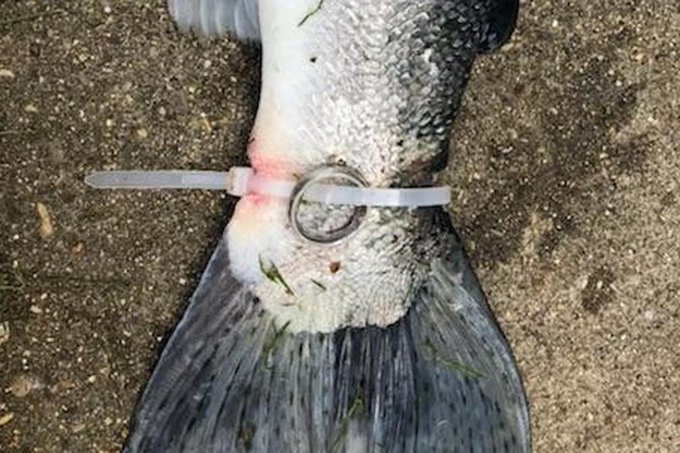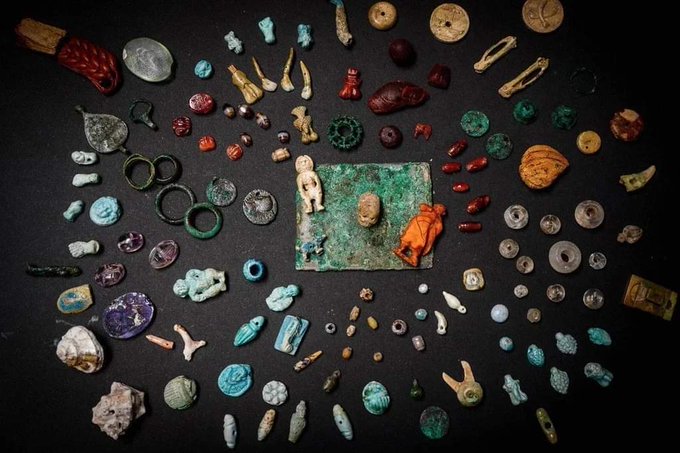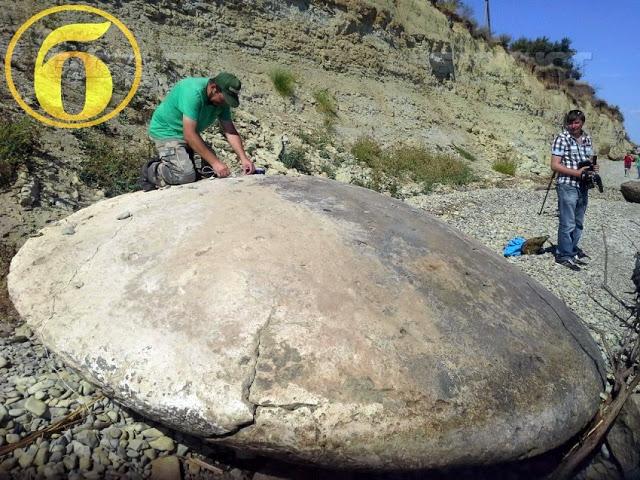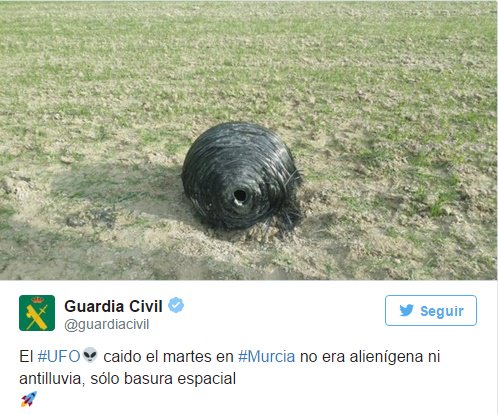Strangest Objects Recently Discovered

April 5, 2025
•16 min read
Here are a list of some strange objects discovered recently.
Being the curious creatures that we are, human beings are constantly discovering amazing new things. But sometimes, those discoveries are so strange, they raise more questions than answers. From truly bizarre artifacts that fell from the heavens, to ancient anomalies found underground, let's explore some of the strangest objects recently discovered.
Cubes With Devanagari Inscriptions Found In UK River
In May 2020, Englishman Will Read was sifting through sediment for precious metals in a shallow river in Coventry, England, when he happened upon something truly unexpected. Initially thinking he’d just picked up some riverbed debris, Will and his two sons quickly realized they’d scooped up something much more intriguing.
They’d actually uncovered cubes made of lead, small enough to hold between your thumb and forefinger, each bearing symbols and numbers intricately inscribed in a grid. They ended up finding more than 60 of the cubes, alongside various coins with holes punctured through them.Metal cubes containing Hindu symbols found in River Sowe in South Coventry, England. They have, 🕉️Sanskrit inscription 🕉️Maa Durga's image 🕉️Astrological imprint We request owner to donate 1-2 cubes to @HSS_UK or @HCI_London for a proper research to find out their age & source.
Dragon Stone
In September 2020, the strange, scaley-looking object in the image below was found in a field in Arkansas. After being shared to Facebook requesting information about what it might be, the suggestions came flying in, ranging from aliens, to fossilized dinosaur eggs, to petrified turtle shells, and giant mushrooms.
Some suggestions were more plausible than others, but when an expert finally chimed in, most ideas were proven wrong. It turned out, the find was actually something known as a ‘dragon stone’, which geologists refer to as a septarian nodule of siderite. Those rocks typically form in muddy sediment, when soils dry out over thousands of years, forming cracks, which are then filled with other minerals like calcite.Most of the time, they’re considerably smaller than the specimen uncovered in Arkansas, making that recent find highly valuable to collectors. So, even if the finder was disappointed they hadn’t uncovered the remnants of an ancient dragon, at least they’d be able to wipe their tears away with fistfuls of cash.Ancient Wolf Found In Permafrost
In 2019, a discovery was made in Eastern Siberia that was equal parts terrifying and fascinating. In the icy conditions, the exceptionally well-preserved remains of an ancient wolf were found, belonging to a sub-species that went extinct tens of thousands of years ago.
That particular specimen is thought to be between 32,000 and 40,000 years old, having been preserved by the permanently-frozen conditions it was found in, which prevented it decaying. The wolf’s fur, brain, snout, and fangs are all still intact, allowing researchers to determine its head to be around 5 inches longer than the modern grey wolves of today.The larger head and wider, more robust jaw allowed the wolf to hunt large herbivores such as woolly mammoths back in its day. While it’s unknown how the wolf’s head ended up detached from its body, it may have been separated by shifts in the permafrost that encased it over thousands of years.
"Ancient" iPhone
In our modern world, considering how often they’re in our hands, smartphones have almost become an extension of the human body. But, as surprising as it sounds, the people of our time aren’t the only ones from history who liked tablet-shaped objects that could fit in your hand.
In 2019, an artifact was discovered at an archaeological site in the Tuva Republic that looked remarkably like a smartphone. But in reality, the artifact which was buried more than 2,100 years ago with its apparent owner, alongside coins and pottery was actually an oversized belt buckle.Archaeologists find 2,100-year-old 'iPhone' buried in a grave in Russian 'Atlantis' express.co.uk/news/world/117…
USB Found In Seal
Sometimes, a discovery is strange not because of what the object is, but where it’s found. Case in point: in 2019, someone’s USB flash drive was discovered sticking out of some frozen leopard seal poop by biologists in New Zealand. The research team were studying the contents of the poop, which had been gathered from a New Zealand beach and frozen, when they found the thumb-drive inside.

Wedding Ring Found In Fish
In 2019, a group of buddies fishing on Lake Michigan snagged a fish with an unexpected bonus: a wedding ring, secured around its tailfin with a cable tie.
this weekend, someone caught a steelhead in lake michigan with a wedding ring zip tied to its caudal peduncle. we should have a creative writing contest with this story as the prompt... chicago.suntimes.com/2019/6/23/1871…

The Sorceress Kit, Pompeii
When a devastating volcanic eruption struck the Roman city of Pompeii in 79 A.D., much of the city was covered in a thick blanket of ash. While those living there perished in the intolerable heat and suffocating volcanic particles, the ash did something peculiar to the remains and belongings of those who lived there. It preserved them, creating an eerie snapshot of life 2,000 years ago.
In modern excavations beneath the ash, countless fascinating discoveries have been made, like one particularly magical find in August 2019. A treasure trove of items, found in a wooden box that had largely decomposed save for the brass hinges, was found in an excavated house, and are thought to have been the possessions of a sorceress."The sorceress kit", a bizarre collection of about 100 trinkets found buried inside a box, in the garden of a house in Pompeii, believed to be a fortune teller's tool kit. Box was likely used to perform fertility and love rituals and to look for omens about birth and pregnancy.
Roman Dodecahedrons
Some strange discoveries are more than just a one-time thing certain types of objects are found repeatedly throughout history, yet each new find reveals surprisingly little about their purpose. That is exactly the case with the objects below known as Roman dodecahedrons.
Airforce Beach Mystery
In 2018, a man visiting Airforce Beach in Evans Head, Australia happened upon an object which can looked like some sort of giant, alien kazoo. That eyebrow-raising object consisted of two pieces of 10ft long plastic piping, wrapped together in black plastic, all bundled up in fishing net.
At one end, there was a plastic dome, seemingly housing some electrical parts, though those didn’t appear to be wired up to anything inside the plastic tubing. The only clue as to the item’s origins or purpose was the word ‘Falcon’ written on the dome. That led some to suggest it may have belonged to Falcon Oil Company, based further south down the coastline in Sydney. If it did, though, the company still hasn’t come forward with an explanation to this day.The Volgograd Discs
Some discoveries people make are either completely ground-breaking, or pretty mundane, depending on who you ask. For the members of the Russian mystery investigation group Kosmopoisk, finding this large in the image below, stone disc on an expedition near Volgograd, Russia, was an extraordinary discovery.
Four Meter Wide “Stone” Disc Found Near Volgograd by “UFO” Hunters facebook.com/permalink.php?…
"Death Star" Space Balls
While unfounded claims of strange objects being from outer space are relatively commonplace, only very rarely are those claims proven to be true. But incidents of puzzling objects falling from the heavens actually have happened on a number of occasions in recent years. In two separate incidents, once in Australia in 2008, and again in Spain in 2015, two almost-identical, spherical objects fell from space into farmers’ fields.
La Guardia Civil descarta riesgo radiológico por un OVNI encontrado en Murcia bit.ly/1l9m4qK
Mystery Of The Monolith
In November 2020, a shiny, metal monolith appeared in the middle of a desert in Utah. The prism-shaped protrusion was spotted by state wildlife officials who were counting bighorn sheep in the area in an overhead helicopter. The discovery instantly caused a stir online, with people drawing links to the monolith that appears in Stanley Kubrick’s 1968 movie, 2001: A Space Odyssey.
While the monolith in the movie ushers in the next stage in human evolution, that didn’t seem to be the case for the one in Utah, as a photographer snapped shots of it being disassembled days later. It turned out to be little more than some plywood and metal sheets dug into the ground, and after it was retrieved, all that remained was its base and a pile of rocks.But that wasn’t the end of the story. Toward the end of November, another metal monolith of remarkably similar appearance was discovered, this time in Romania. Less than a week after that, yet another monolith of the same kind appeared atop Pine Mountain in California. With each of the monoliths bearing a remarkably similar appearance, it seemed that they were unquestionably linked.But who was responsible, what the intended message was, and whether it would turn out to be a publicity stunt, has yet to be confirmed. That said, rumors have emerged that the highly-publicized monoliths may be a novel attempt to publicize progressive-metal band, Tesseract’s latest album, which features similar monoliths on the cover. As of yet, though, the answer remains unconfirmed.10,000 Years Old Armadillo Shells
While fishing along the banks of a creek in Buenos Aires, Argentina in 2019, one man stumbled upon something that definitely wasn’t a fish. Noticing an unusual rock along the muddy bank, he went to clear the dirt away to pull it out, but soon realized it was much larger than he’d initially expected, and it had a peculiar, cobbled texture.
It soon became clear that wasn’t any ordinary rock, and when experts were called in to excavate the object, it was found to be a remarkably well-preserved fossil. To be precise, that was the fossilized shell of a glyptodon, an ancient, giant relative of armadillos with a huge, bone-plate shell and club-like tail that went extinct around 10,000 years ago.






















